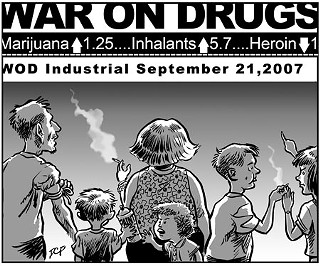Reefer Madness
Good news! Marijuana use remains steady
By Jordan Smith, Fri., Sept. 21, 2007
The results of the annual national drug-use survey released Sept. 5 apparently leave little doubt in the mind of drug czar John Walters that the nation's War on Drugs actually is working. "Drug use is a terrible drag on our society and our economy," Walters said in a press statement. "Outdated notions casting drug use as a 'recreational' or 'lifestyle' choice have resulted in generations of persistent and ruinous drug use. But we know that this is a problem that can be made smaller," he continued, warming up to the "big news" (drumroll, please): "Fewer teens using drugs today means fewer Americans suffering destructive consequences tomorrow."
Man, I wish I had his moxie. Instead, after slogging through seemingly endless pages of the newly released 2006 National Survey on Drug Use and Health, I was left with a headache and a load of unanswered questions, including: Is it too early for a drink?
An annual affair produced by the U.S. Department of Health and Human Services' Substance Abuse and Mental Health Services Administration – wherein 67,500 "civilian, noninstitutionalized" Americans ages 12 and up are quizzed about their past and current drug use (that is, alcohol, tobacco, and nine other categories of illicit drugs) – the survey is, in theory, meant to provide some national barometer of drug use. In reality, it is a bunch of numbers that seem to float in space, with little attachment to real trends over time (that is, since the early Seventies), that when analyzed critically, tend to leave the reader a little older and none the wiser. Has drug use ebbed? Maybe. Have new trends in drug use emerged? Probably. Does the annual survey bolster the efficacy of federal anti-drug strategies – such as the youth anti-drug media campaign championed by Walters' White House Office of National Drug Control Policy? Not bloody likely. But that hasn't stopped Walters from expressing his satisfaction with the 2006 numbers – especially the "fact" that overall, drug use among adolescents (ages 12-17) has declined since 2002, to a five-year low of just 9.8%. And, Walters noted, marijuana use among adolescents also has dropped to just 6.7% in 2006. In both cases, however, the decline in use is modest: In 2002, 11.6% of adolescents reported using illicit drugs – just around 2% higher; similarly, in 2002, 8.2% of teens reported using marijuana – meaning "current marijuana use" among the 12-17 set has dropped by a whopping 1.5%.
The same breathlessness given to these declines is not afforded to the fact that underage drinking, for example, remains virtually unchanged over the same period, at 28.3%. Nor did Walters mention a much more troubling increase, notes Bruce Mirken, communications director for the Marijuana Policy Project, in the use of inhalant drugs by youth and particularly among the 14- and 15-year-olds. Walters & Co. "have this pattern of cherry-picking fragments of data that make the points they want to make and ignore the rest," he said. Mirken points out that although youth drug use in general, and marijuana use in particular, has declined in recent years, the rate of current drug use among adolescents is far higher than it was in the early Nineties. In 1992, the rate of teen illicit drug use was 5.3%, and marijuana use was just 3.4%. In other words, teen drug use is nearly double what it was 15 years ago. Although Walters and Health and Human Services Secretary Michael Leavitt reportedly have said that attempting to do such time-lapse comparison isn't a good idea since SAMHSA survey methodology changed in 2002, it is worth noting that a second government-funded annual youth drug survey, the so-called "Monitoring the Future" survey, never has changed its methodology and – surprise, surprise! – reflects amazingly similar long-term use trends.
In all, the survey reveals that drug use among the entire population has remained stable since 2002, with about 8.3% reporting current illicit drug use. Interestingly, 72.8% of current users reported using marijuana, and nearly 53% of all current drug users reported that marijuana was the only illicit drug they use, which, at least on its face, kind of puts a dent in the feds' whole marijuana-as-gateway-drug theory. In all, the rate of marijuana use has remained stable since 2002, at around 6% each year.
What does all this tell us? Good question. First, the fact that drug use in general, and marijuana use in particular, has remained relatively stable in recent years is cause to question the overall goal of fighting – let alone winning – a war on drugs. Thirty years and billions of dollars later, where are we? Still toking up. It makes one wonder whether the money spent on things like marijuana eradication and the arrest of pot smokers (now up to nearly 800,000 per year, the majority for possession only) actually is worth it. Second, the small decline in the use of illicit drugs by adolescents is a good thing – it is, of course, a noble goal to keep kids away from mind- and mood-altering substances. While drugs are neither good nor bad, they are powerful substances, the use of which should not be taken lightly – that is, after all, among the reasons that we regulate alcohol and tobacco (even if the survey suggests we don't necessarily do the best job of it). But touting these small declines tends to obscure a larger question: Why does a 13- or 14-year-old begin using drugs in the first place? It is hard to imagine that the answer to that question, let alone its remedy, could be found in our current, trite strategies and rote approaches, like the costly and ineffective just-say-no media campaign. "The bottom line," says Mirken, is that a kid involved in drugs has other issues. "This is a kid in trouble – why are they not looking at that?" Perhaps because it is more "politically convenient to blame a drug," like marijuana, he says, than it is actually to confront the larger social problems at work. And those, of course, won't be found in any drug-use survey.
Got something to say on the subject? Send a letter to the editor.









